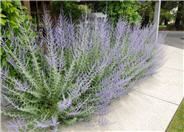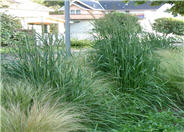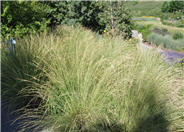
Common name:Russian Sage
Botanical name:Perovskia atriplicifolia
Russian sage may be the ubiquitous low-water garden plant. With its grey green, aromatic foliage, and azure blue spires, it provides a long-lasting show in hot, dry gardens. It grows to 3 to 5 feet tall, and nearly as wide. It is a woody perennial and forms a very hard trunk over time. It is both airy and substantial, and partners well with herbaceous perennials, woody shrubs, or ornamental grasses. It also would grow well against a south or west facing wall or fence.

Common name:Feather Reed Grass
Botanical name:Calamagrostis acutiflora
Feather reed grass is perennial grass that grows 4 to 6 feet tall and 1 to 2 feet wide. It is ideal in spaces where some vertical interest would be valued. It is very upright, though the grass blades are gently arching. Flower plumes appear mid June and emerge a light green but quickly turn to pinkish purple. The flower is very airy and feathery, hence the name. Flower is looser than 'Karl Foerster.' Plumes are very persistent into the winter months. Slightly less erect than it's popular kin, 'Karl Foerster.'

Common name:Switch Grass
Botanical name:Panicum virgatum
Switch grass is a north American native and an original component of the Midwestern Plains. It is a warm-season (it goes dormant during the winter) clumping grass with an upright form, interesting flowers, showy fall color, and a great winter presence. It grows from 4 to 7 feet tall and about half as wide, though in time may spread wider. Airy, delicate flowers appear in mid-summer, hanging along an arching, wiry stem, and are pink to red to orange. Foliage turns yellow to orange in the fall, and the flowers turn a silvery white. there are now many cultivars to choice from, and they all make excellent and low-care additions to perennial or shrub borders, or in more naturally styled settings.
| Designer: Glen Trope | Modern Style 27 |
Photographer: GardenSoft |
Water Saving Tip:
Group plants in your garden according to their water needs (hydrozone).
